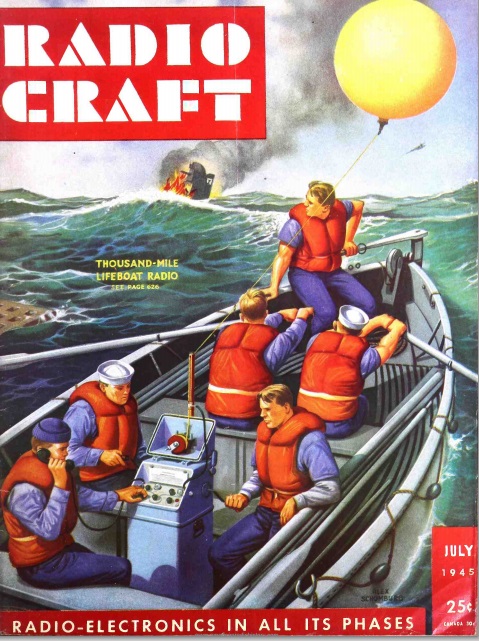Seventy years ago, the cover of Radio Craft magazine, July 1945, featured this new radio designed for use in lifeboats. The lifeboats of passenger ships were required to be equipped with radio, and when the U.S. entered the war, this requirement was extended to cargo ships as well. The early sets were battery operated on 500 kHz and had limited range and transmitting time. The Germans were the first to develop a lifeboat radio similar to this one, the Notsender NS2. It was powered with a hand crank, and designed to be held between the operator’s legs. In addition to powering the unit, the crank keyed the transmitter, sending SOS, alternating with long dashes to facilitate direction finding. It also had provision to be keyed manually. It operated on the distress frequency of 500 kHz, and utilized a wire antenna held aloft either by a hydrogen balloon or kite.

American BC-778 “Gibson Girl.” Photo by ArnoldReinhold via Wikipedia, file licensed under the Creative Commons Attribution-Share Alike 3.0 Unported license.
The British soon captured a few examples, and duplicated them as transmitter type T1333. In 1941, the British, recognizing that they didn’t have the industrial capacity to manufacture the sets in quantity, sought a North American builder. The U.S., recognizing the value of the unit, proceeded with the project jointly, resulting in the BC-778, later upgraded to the AN/CRT-3, which became known as the “Gibson Girl” transmitter. The earlier version, the BC-778, operated on 500 kHz exclusively. Later models also operated on 8280 or 8364 kHz. The American version could also use the generator to power a signal light.
All of the wartime units included a hydrogen generator to fill the balloon, as well as a box kite which could be used to hoist the antenna.
The accompanying article was written by an executive of the manufacturer, Radiomarine Corporation of America, and touted the advantages of the new set. It operated on both 500 kHz and on 8280 kHz, and the primary means of hoisting the antenna was with a balloon, but one filled with a helium cannister. But it had two notable differences. First of all, it was capable of transmitting radiotelephone signals as well as radiotelegraph. But it also included a receiver capable of tuning 8100 – 8600 kHz. Thus, it would allow the occupants of the lifeboat to communicate with rescuers, and also with neighboring lifeboats.
While it was not used during the war, it appears that sets similar to the one shown in the article did go into production. The model ET-8053 appears to have most of the same features, albeit in a more portable set. The model ET-8030 appears to be very similar to the one shown.
References
Click Here For Today’s Ripley’s Believe It Or Not Cartoon ![]()


Any chance an ET-8030 (operational) might be available to purchase? How about a complete Gibson Girl set?
Pingback: 1949 Emergency Beacon Transmitter | OneTubeRadio.com